

First American pope:
White Sox fan, Villanova grad, Peru missionary, Vatican lead er

first American pope, our new Holy Father (OSV News)
By Maria Wiering OSV News
Standing on loggia of St. Peter’s Basilica, newly-elected Pope Leo XIV smiled, waved, and appeared to hold back emotion May 8 as he introduced himself to the world as the 266th successor to St. Peter—the first American to hold that role.
His first words: “Peace be with you!”.
MIDWEST ROOTS
Pope Leo, 69, formerly Cardinal Robert F. Prevost, OSA, is the first pope from the United States. He assumes the chair of Peter with multifaceted leadership experience: He grew up in the Midwest, graduated from Augustinian-run Villanova University in 1977 with a math degree, ministered as a bishop in Peru, and led the Vatican dicastery that helps appoint, form, and retire bishops.
Born in Chicago and ordained a priest for the Order of St. Augustine in 1982, Pope Leo held major leadership roles in his religious community before being ordained a bishop in 2014, ministering in the dioceses of Chiclayo and Callao, Peru. He was installed as the prefect of the Holy See’s Dicastery for Bishops— the powerful Vatican body responsible for choosing bishops throughout the world—in April 2023 and was elevated that September to the rank of cardinal.




In 2013, as he prepared to leave his role as the Augustinians’ global leader, he told Rome Reports that Augustinians “are called to live a simple life at the service of others, and in a special way, to reach out
to those who are poor ... which includes, of course those who are monetarily poor, but there are many kinds of poverty in today’s world.”
EARLY YEARS
Pope Leo was born in suburban south Chicago on Sept. 14, 1955. His family attended St. Mary of the Assumption Parish in Dolton, IL, and he is reportedly of Italian, French, and Spanish descent. In 1977, Pope Leo entered the novitiate of the Order of St. Augustine in St. Louis. In September 1978, at the age of 22, he professed first vows, and three years later, he made solemn vows.
He earned a theology degree at the Catholic Theological Union in Chicago before going to Rome to study canon law at the Pontifical University of St. Thomas Aquinas, also known as the Angelicum, receiving his licentiate in 1984. Three years later, he completed his doctorate, writing on “The role of the local prior in the Order of Saint Augustine.”
By the time he received his doctorate, he had been ordained a priest for the Order of St. Augustine for five years and had ministered for a year in the order’s mission of Chulucanas in Piura, Peru.
In 1987, he was elected the vocations director and missions director for his order’s Midwest province, Our Mother of Good Counsel. A year later, he went to
Peru, to direct a joint formation project for the region’s Augustinian
Over the course of a decade in
served as the community’s
CONTINUED // Page 10
BISHOPS OFFER THANKS AHEAD OF NEW POPE’S BALCONY GREETING Philadelphia (OSV News)
As the world waited to learn the identity of the next pope, bishops were already expressing their gratitude for the choice. Archbishop Nelson J. Pérez of Philadelphia— who was en route home from an archdiocesan pilgrimage to Rome, told OSV News, “While I don’t know who it is yet … I praise God for giving us a pope so quickly. A wonderful blessing.” Writing on X, Bishop Robert E. Barron of Winona-Rochester, MN, said, “Friends, please join me in a prayer of thanksgiving for the cardinal electors, and for our new pope as he prepares to step out on the balcony.” Archbishop José H. Gomez of the Archdiocese of Los Angeles reposted the archdiocesan announcement on X, simply showing an image of the white smoke pouring from the Sistine Chapel chimney and the words, “Habemus Papam!” ©OSV News

Trujillo,
aspirants.
Trujillo, he
HABEMUS PAPAM! Cardinal Robert Francis Prevost, OSA, who has taken the name Pope Leo XIV, was elected the 267th pope, the 266th successor of St. Peter and the Bishop of Rome. Most recently Cardinal Robert F. Prevost has served as the prefect of the Dicastery for Bishops under Pope Francis. Let us join in praying for Pope Leo XIV, the
CARDINALS AWAIT NEW POPE—The cardinals who elected Pope Leo XIV May 8, 2025, stand on the balconies of St. Peter’s Basilica at the Vatican to watch as he greets the crowd for the first time and gives his blessing “urbi et orbi” (to the city and the world) (CNS photo/Pablo Esparza)

“IAND YOU WILL SEE
Bp. Edward M. Rice
Be a voice for justice, love & compassion COME,
tell you, whatever you did for one of the least of my brothers and sisters, you did for me,” Matthew 25:40. That is the beginning of a letter that I received in the mail dated April 25, 2025. It makes reference to the passing of Pope Francis, and then said, “In these troubled times, we urge you to personally speak out with authority against actions that are contrary to the teachings of Jesus.”
The letter continues:
“You and other Church leaders cannot remain silent as our vulnerable brothers and sisters both around the world and here in the United States (are harmed). In this war on the poor, the marginalized, workers, immigrants, and those with different views:

Be a voice for justice, love and compassion. Speak up publicly on behalf of those who have been harmed.
Be fearless, embracing and preaching the priorities of the gospel.
Stand steadfast in truth despite the powerful forces that confront you.
Console those who are vulnerable and harmed. Shepherd those who are inflicting their hurt … without condemnation, invite them into the lifealtering embrace of love of neighbor.
Lead us, walk with us, and encourage us to become even more fully who we are called to be—bearers of love who refused to relinquish our moral authority or languish and despair. Speak out!”
I think all of our hearts are torn when we hear of the separation of parents and children. All of us feel like our country can do so much better regarding those who desire a safe place to live and raise their family. That is what all of us want. I’ve mentioned before, the great hope that is expressed at the Statue of Liberty: Give me your tired, your poor, your huddled masses yearning to breathe free, the

We must regain the conviction that we need one another, that we have a shared responsibilty for others and the world, and that being good and decent are worth it.
–Pope Francis, “Laudato Sit,” No. 229
the Roman Catholic Church and my siblings are all productive members of society. In a sense, we captured the American dream, a dream laid down through the hard work of our ancestors. I think many of you could say the same thing.
In his document on the Sacred Heart, our late Holy Father, Pope Francis, looking around at all the suffering of our world offered, “Perhaps the most decisive question we can ask is, “Do I have a heart?”
beside the golden door!”
All of us want to live in safety. We want neighborhoods free of drugs and crime and violence. There is absolutely no question about that. And our public officials have a responsibility to provide safe neighborhoods for us to raise our families. And, unless you were native to this land, every one of us can probably trace our lineage back to just a few generations to where we were immigrants. For some, it was the potato famine and a lack of opportunity for the Catholics in Ireland. For others, it was the German Kulturkampf and the conflict between Church and state. Be it religious freedom, poverty, or simply the desire to live peacefully, our country has always welcomed new waves of immigrants.
I’ve stated before that my family came from Ireland by way of Canada. Why Canada? I’ve often assumed that maybe we were undocumented, and maybe my ancestors would not have been allowed through Ellis Island and so they made their way to the United States through Canada. That’s total conjecture on my part, but it may be true. Some three or four generations later, I am a Bishop of
I end this column with the expanded selection from Matthew 25:35-40, “... for I was hungry and you gave me food, thirsty and you gave me drink, a stranger and you welcomed me, naked and you clothed me, sick and in prison and you came to visit me.” And it is only after we have responded to those needs that our Lord proclaims, “I tell you, whatever you did for one of the least of my brothers and sisters, you did for me.”.
O Sacrament Most Holy, O Sacrament Divine, all praise and all thanksgiving, be every moment Thine. Christ is Risen: Alleluia! ©TM


wretched refuse of your teeming shore. Send these, the homeless, Tempest tossed to me, I lift my lamp
DIOCESAN NEWS/ADVERTISING
Pastor honored on his 35th anniversary by parish Vocations Committee
Cape Girardeau, MO
On March 24, 2025, Fr. Rick Jones, the pastor of St. Vincent de Paul Parish, in Cape Girardeau, MO, celebrated the 35th anniversary of his ordination to the priesthood.
The Vocation Committee at St. Vincent de Paul honored him by creating a beautiful bulletin board filled with pictures of his life and his ministry as a priest. Many parishioners wrote messages of congratulations and thanksgiving to him for his priestly ministry.
“Father Rick’s ministry is characterized by his strong faith, guidance from the Holy Spirit, and joyful service to God’s people with love and compassion,” said Sandy Murphy, parishioner. “He dedicates himself to guiding souls to Christ. Father Rick has touched countless lives during his 35 years as a priest.”
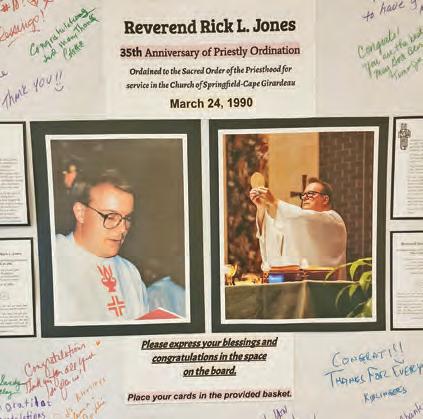
as a priest of the Diocese of Springfield-Cape Girardeau, he has served all across southern Missouri in Piedmont, Van Buren, Williamsville, Neosho, Webb City, Branson, Forsyth, Fredericktown, and since 2017, at St. Vincent de Paul Parish, in Cape Girardeau. Father Jones also serves as Director of the diocesan Clergy Formation Committee.
A prayer was issued to parishioners from the parish Vocations Committee:
Almighty and merciful God, we offer You our sincere thanks and gratitude for Father Rick who has faithfully served You for 35 years.
We thank You for the grace You have bestowed upon him and for the gift of his ministry.
May Father Rick be blessed with Your presence, strength, and courage as he continues his ministry.
A Cape Girardeau native, Fr. Jones was ordained March 24, 1990, in St. Mary of the Annunciation Cathedral by The Most Rev. John J. Leibrecht. His first assignment was as Associate Pastor in Immaculate Conception Parish, Springfield, where he also served the Diocese as a Vocations Resource Priest. In his 35 years
We are grateful for the many ways he has touched our lives, for his wisdom and guidance, his commitment to the Gospel, and his tireless efforts to bring souls to Christ.
May he be filled with joy and peace as he continues to serve You and Your people.
We ask this through Christ our Lord, Amen. ©TM
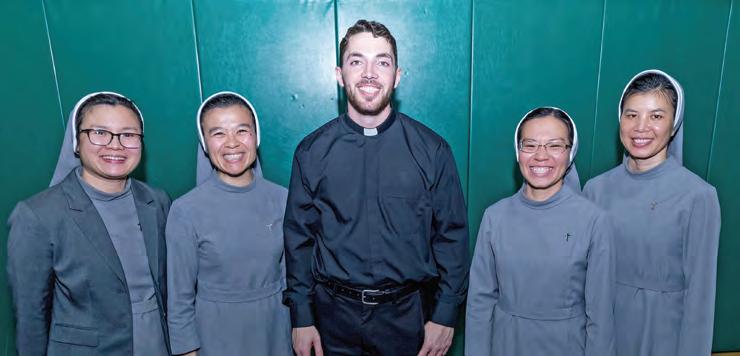
JFIRST FRIDAY MASS for VOCATIONS
oin Bishop Rice on the First Friday of each month to pray for an increase in Vocations to the priesthood and religious life in the Diocese of SpringfieldCape Girardeau. The Rosary will be prayed following the liturgy. Parishes are invited to do the same as we continue to pray for more vocations to the priesthood and religious life in the diocese.
Fri., June 6 St. Agnes Cathedral, Springfield 5:30 p.m.
Fri., July 4 St. Agnes Cathedral, Springfield 9 a.m.
Fri., Aug. 1 St. Agnes Cathedral, Springfield 5:30 p.m.
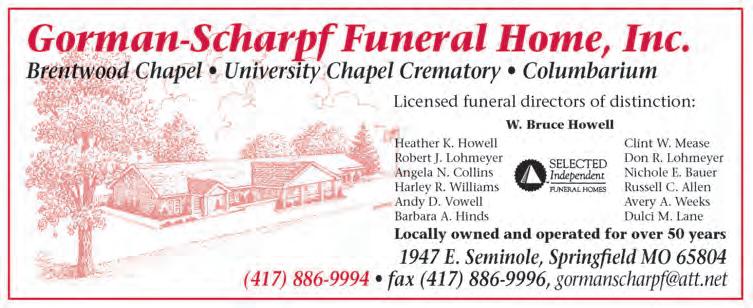
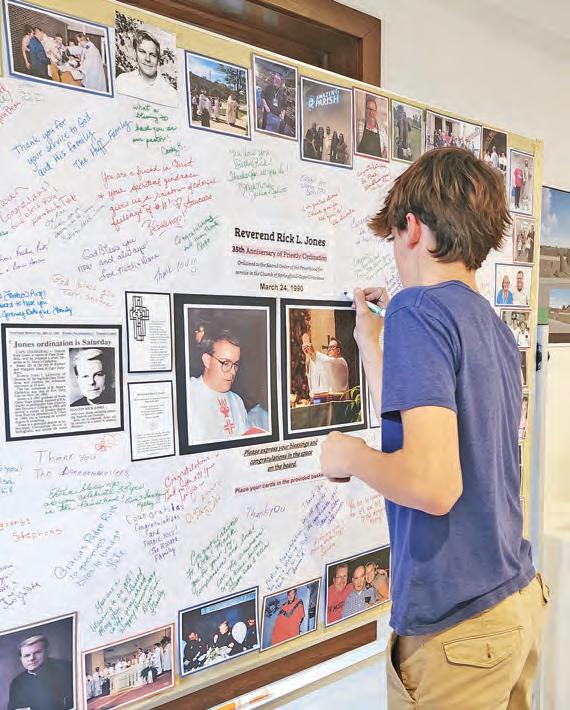
35 YEARS A PRIEST—Many parishioners wrote messages of congratulations and thanksgiving to their pastor, Fr. Rick Jones, in gratitude for his priestly ministry. The Vocation Committee at St. Vincent de Paul Parish, Cape Girardeau honored him by creating a beautiful bulletin board filled with pictures of his life and vocation as a priest. Father Jones marked his 35th anniversary on March 24 (Submitted photos)

By Bishop Emeritus John J. Leibrecht
ANOTHER WALK THROUGH: ‘Walking Together’
Before his retirement in 2008 as the Fifth Bishop of the Diocese of Springfield-Cape Girardeau, Bishop John Leibrecht wrote a standing column in The Mirror entitled, “Walking Together.” At the end of each article, Bp. Leibrecht would normally share a funny story referencing his travels to the schools, or time with friends, family, or other bishops. The Mirror has decided to share a few of these in an ongoing series entitled, “Another walk through: ‘Walking Together.’” We hope you enjoy them.
March 26, 1993 “My children are at a perfect age,” a father said to his friend. “They’re too old to cry at night and too young to drive the car.”
April 9, 1993 The mother of a small boy recently told me about her priest as he processed down the middle aisle, amply sprinkling everyone with holy water. The son at her side, not paying attention was liberally splashed on the head with the
water. Stunned and not knowing where it came from, he said angrily, “Mommy, somebody just spit on me!
April 16, 1993 A closing hymn at Mass had six stanzas and almost all of the congregation was singing with enthusiasm. Immediately after the fourth stanza, and in that split-second of silence before beginning the fifth stanza, an impatient little boy said loudly, “No more!”
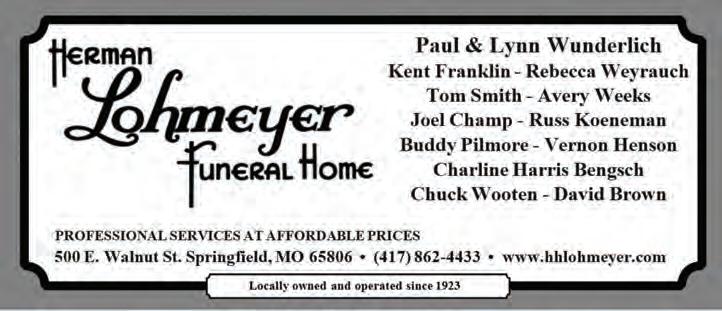
DIOCESAN NEWS/ADVERTISING
ANNOUNCEMENTS
Aurora—Holy Trinity Parish will have First Saturday devotion to the Blessed Virgin Mary, every first Saturday with a rosary at 7:30 a.m., followed by Mass at 8 a.m.
Buffalo—St. William Parish will have its 45th Annual Yard, Plant & Bake Sale, Thu., May 15, 8 a.m.-4 p.m., and Fri., May 16, 8 a.m.-4 p.m., in the church hall, located at 404 N. Locust St.
Jackson—St. Ann’s Sodality/CCW will have its Rummage & Plant Sale, Fri., June 6, 7 a.m.-5 p.m., and Sat., June 7, 7 a.m.-1 p.m., in the school gymnasium at Immaculate Conception Church. Lots of Nice Stuff at a Nice Price!
Sikeston—The Catholic Grandparents Association will sponsor Vacation Bible School: The Great Journey With Jesus, June 23-27, 8:30-11:30 a.m., grades K-5 in STFX school. For more information, please call Karen at the Church office, (573) 471-2447.
Parishes and organizations are invited to submit notices of future events to be printed on a space-available basis. There is no fee.
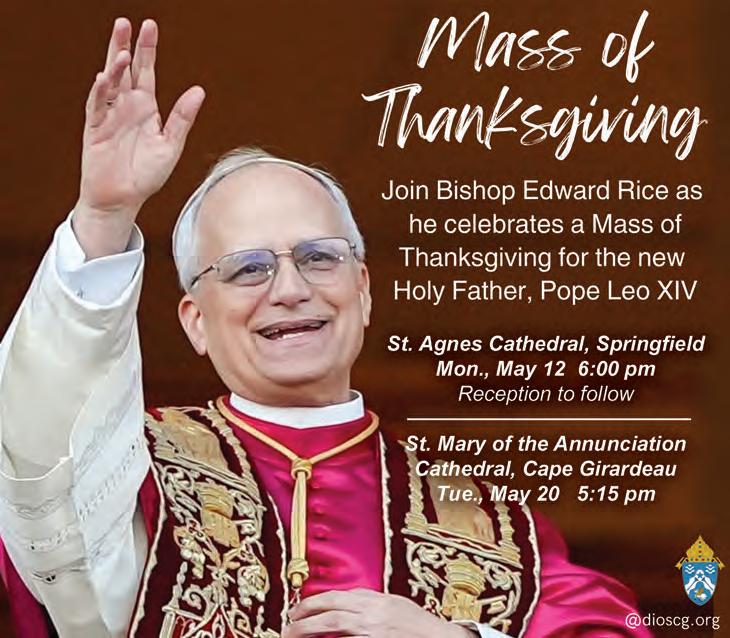
FORMER GLENNONVILLE TEACHER CELEBRATES 70 YEARS AS URSULINE SISTER
Sister Francis Louise Johnson, OSU
Maple Mount, KY
Aconsecrated religious who served in St. Teresa Catholic School, in Glennonville, MO, is among 12 Ursuline Sisters of Mount Saint Joseph celebrating anniversaries of religious profession in 2025.
Sister Francis Louise Johnson, celebrating 70 years, taught at St. Teresa School, Glennonville in 1973. She also taught in Affton and Florissant, as well as in schools in Kentucky, Nebraska, and New Mexico. A native of Waverly, KY,

8 Babies in Year One: Catholic Charities celebrates one year of LifeHouse Cape Girardeau
Cape Girardeau, MO
April 19 marked the one-year anniversary of Catholic Charities of Southern Missouri’s (CCSOMO) LifeHouse Crisis Maternity Home on the Little Flower Campus in Cape Girardeau. In its first year of operation, 12 mothers found a safe place to heal and grow, and eight babies were welcomed into the world.

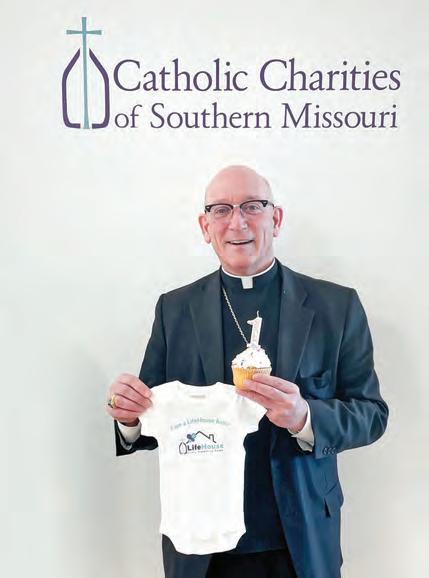
LifeHouse is a residential program for pregnant women experiencing homelessness. It offers individualized case management, pre- and post-natal education, and parenting and lifeskills training. The Little Flower Campus has rooms for 15 mothers along with a classroom, kitchen, community room, and office space for CCSOMO staff.
Missouri historically has a high rate of both maternal and infant mortality. LifeHouse works to enhance postpartum health for mothers and infants by providing shelter, prenatal education, nutrition classes, and connection to prenatal care (OB) to support healthy pregnancy outcomes. The program also offers postpartum care support and assistance in establishing pediatric care for children.

Sr. Johnson was raised in Mayfield, KY. From 200317, she was coordinator of the Guest House at Mount Saint Joseph. She is retired at the Motherhouse, where she is active in the Powerhouse of Prayer.
Those wishing to send congratulations to Sr. Johnson may address them to Mount Saint Joseph, 8001 Cummings Road, Maple Mount, KY 42356. ©TM
“As we move forward–guided by a clear mission to serve those in need, fueled by the passion of the Cape Girardeau community, and driven by the unwavering dedication of our teams–we’re counting lives touched, supported and saved,” said Ken Palermo, CCSOMO

Chief Executive Officer.
“This first year has seen an incredible outpouring of support from the community,” said Rick Cuba, chair of the LifeHouse in Cape Girardeau Capital Campaign, citing 1,395 volunteer hours logged at Little Flower Campus.
Volunteers are essential to LifeHouse as they prepare meals, provide respite childcare, transport residents to appointments, work, daycare, and more.
“I am proud to support such an incredible mission, and I encourage people to continue to support this important work through financial gifts, volunteering, or attending our annual fundraiser, the LifeHouse Gala, Cape Girardeau,” Cuba said.
The 2025 LifeHouse Gala, Cape Girardeau will take place on November 1, 2025, at the Drury Plaza Hotel Conference Center. For more information, visit: https://ccsomo.org/ lifehouse-gala-cape/. ©TM

LEARN ABOUT THE MANY EMPLOYMENT OPPORTUNITIES AROUND THE DIOCESE!
DioSCG.org/ employment

YEARS of the

How The Name For ‘The Mirror’ Was Chosen: Issue #1 — April 18th, 1965
The naming of any new venture is always a difficult task, whether it be a new baby, a business, or a new newspaper. The picking of the name for the diocesan newspaper for the Diocese of SpringfieldCape Girardeau was no easy task either. The choice of The Mirror was revealed last week in a letter by His Excellency, Bishop Ignatius Strecker. The publication of the name followed the final vote of judges on suggested names for the publication.
418 SUGGESTIONS WERE RECEIVED
Priests, religious, and laypersons of the diocese, as well as persons outside the diocese submitted 418 suggested names for the newspaper. These were submitted to seven judges— one layman, one sister, two laywomen, and three priests from across the diocese. Working independently of one another, they were asked to choose no more than five and no fewer than three names from among the 418 original suggestions. Twenty-nine names were selected, which were resubmitted to the judges. On a basis of five points for first choice, four points for second choice, and finally down to one point for fifth choice, the choice of name was narrowed to three possibilities. The three names from which the judges were to make a final choice were submitted to them in the order in which they were drawn from a hat. They were The Mirror, The Word, The Image. Judges were asked to express their preference, voting five points for first choice, three points for second choice, and one point for third choice. In his final letter to the judges, Bishop Strecker wrote, “We hope for a winner! All three names seem to convey the purpose of the Catholic Press— all seem appropriate— any of the three should receive the approval of our people.”
THE WINNER
The winning name is The Mirror with 29 points. Judges gave The Word 21 points and The Image 13 points. Winners of the $100 prize are: Miss Mary Johnson, R.N. and Miss Linda King, R.N., Lay Extension Volunteers working at St. FrancisMountain View Memorial Hospital, Mountain View. The volunteer nurses think the name, The Mirror, appropriate in view of an address by Pope Paul in the press. The Holy Father said, “A newspaper… is a reflection of the non-sacred character of life as it is lived. A newspaper is a mirror, and must be an ample and faithful mirror. It is answerable to a fundamental requirement of its own: to inform, to report the news, to tell things as they are, to serve the truth, which we might describe as photographic, the truth of events, of facts, of daily happenings, the objective truth of the world that surrounds us and move around us.” The winning volunteers also feel, in the Holy Father’s words, that as a Catholic newspaper, The Mirror, “...should not only inform but also form the reader. It must stimulate the kind of healthy outlook that classifies facts in accordance with higher principles and, in one sense or another, idealizes them, making them food for thought for whoever comes to know them by reading the paper.” On another occasion, speaking recently to Catholic journalists,

the Holy Father said, “your Catholic Press…is the mirror of the world— telling things as they are in the truth.”

Concerning the final choice, Bishop Strecker said, “The great number of suggestions indicates the interest and enthusiasm of the people of the diocese in their new newspaper. I am pleased with the final decision of the judges; and I congratulate Miss Johnson and Miss King.” ©TM

THE MODERN POPES: Get to know the 11 popes before Francis
OSV News
The following is a snapshot of the papacies of the 11 popes that preceded Pope Francis, from Pope Benedict XVI (2005-2013) to Blessed Pope Pius IX (1846-1878).
Pope Benedict XVI: Brilliant humility
(r. 2005-2013)
Pope Benedict XVI, who died Dec. 31, 2022, at age 95, was far more than the pope who resigned, although he was the first to do so in nearly 600 years. A towering figure in the Church for over half a century, Joseph Ratzinger shaped Catholic thought as an innovative theologian, head of the Congregation for the Doctrine of the Faith, and ultimately as pope. A key architect of the Church’s post-Vatican II path, he championed continuity over rupture, resisting secular trends like relativism. Ordained a priest in 1951, he rose to prominence during the Second Vatican Council and later helped draft the Catechism of the Catholic Church. Elected pope in 2005, Benedict emphasized the harmony of faith and reason and sought reform rooted in tradition. Though criticized over the Church’s handling of clergy abuse scandals, he was among the first Vatican officials to take decisive action. After resigning in 2013, he lived in quiet prayer until his death.

fall of Soviet communism, and efforts to strengthen Catholic-Jewish relations marked his historic pontificate. His stances on sexuality, women’s ordination, and centralized authority received both celebration and criticism, yet his leadership reshaped the modern Church. He authored landmark encyclicals, advanced ecumenical dialogue, and oversaw the publication of the Catechism of the Catholic Church After recovering from being shot in 1981, he resumed his strenuous schedule, but starting in the early 1990s he suffered visibly from Parkinson’s. He died April 2, 2005. Canonized in 2014, he remains a defining figure of the post-Vatican II era.
Blessed
Pope
John Paul I:
The September pope (r. Aug. 26-Sept. 28, 1978)
Pope St. John Paul II: Witness to the world (r.
1978-2005)
Pope St. John Paul II, who led the Church from 1978 to 2005, was a prodigious figure of faith, intellect, and global influence. A charismatic philosopher, athlete, poet, and fierce opponent of communism, the Polish-born Karol Wojtyla brought vigor and vision to a world and Church in need of hope. He championed orthodoxy, human dignity, and moral truth, famously urging Catholics: ”Be not afraid.” His 104 international trips, pivotal role in the

Council to its conclusion, championed global outreach through historic papal travels, and sought unity with the Orthodox Church. His 1968 encyclical, “Humanae Vitae” (“Of Human Life”), reaffirming the Church’s stance against artificial birth control, sparked widespread dissent. Despite suffering from comparison with his charismatic predecessor, Pope St. John XXIII, Pope Paul VI remained faithful to his mission, often torn between progressive and conservative impulses. He decried the spiritual confusion of the era, famously warning of the “smoke of Satan” entering the Church. Beatified in 2014 and canonized in 2018, his legacy is now viewed as prophetic, pastoral, and foundational to the post-conciliar Church.

policy in response to Nazism and Communism. Though maintaining wartime neutrality, Pope Pius XII condemned totalitarian ideologies, aided Jews and refugees, and acted as a diplomatic channel between the Allies and anti-Hitler Germans. After the war, he resisted Communist expansion in Eastern Europe and intervened in Italian elections to prevent a Communist victory.

Doctrinally, he advanced biblical scholarship and liturgical reform, and in 1950 infallibly defined the assumption of Mary. His critics question whether he spoke out forcefully enough against the Holocaust, though many contemporaries— including Jewish leaders—praised his efforts to save lives. Despite controversy, Pope Pius XII is recognized for his moral leadership during a time of global crisis. He was declared “venerable” by Pope Benedict XVI in 2009.

Cardinal Albino Luciani took the name John Paul I to honor his two predecessors. Known for his humility, simplicity, and radiant smile, he was seen as a pastoral figure who could lift the Church’s spirits after Pope St. Paul VI’s difficult final years. Born in northern Italy in 1912, Luciani served as bishop of Vittorio Veneto, participated in the Second Vatican Council and became patriarch of Venice. A strong advocate for catechesis and social justice, he supported “Humanae Vitae” (“Of Human Life”) while emphasizing patience and compassion. Though his papacy lasted only 33 days before his sudden death, he had outlined a sixpoint vision centered on renewal, unity, and peace. His unassuming style and rejection of papal pomp won admiration, though confusion around his death fueled conspiracy theories. Despite his short tenure, Pope John Paul I left a legacy of gentleness and humility. His cause for sainthood was opened in 1990. He was beatified in 2002.
Pope St. Paul VI: Prophet for the modern world (r. 1963–1978)
Pope St. Paul VI, born Giovanni Battista Montini in 1897, was a complex and dutiful leader whose papacy helped shape the modern Church amid turbulent times. A former Vatican diplomat and close aide to Pope Pius XII, Pope Paul VI brought deep institutional knowledge and pastoral experience to the role. He guided the Second Vatican
Pope St. John XXIII: Joyful prophet of renewal (r. 1958-1963)
Pope John XXIII, born Angelo Roncalli in 1881, was elected pope at age 77, widely expected to be a transitional figure. Instead, his humility, warmth, and vision reshaped the Church through the Second Vatican Council, which he convened in 1962 to engage the modern world with renewed faith and clarity. A peasant’s son and experienced diplomat, Roncalli had served in war zones and helped Jews during the Second World War. As pope, he broke with formality, welcomed diverse voices, and promoted unity and peace. His landmark encyclicals, “Mater et Magistra” (“Mother and Teacher”) and “Pacem in Terris” (“Peace on Earth”) advanced Catholic social teaching, emphasizing workers’ rights, human dignity, and global cooperation. During the Cuban Missile Crisis, he played a quiet but crucial mediating role. He died of cancer in 1963, having set the Church on a bold path of “aggiornamento” (updating) and “ressourcement” (return to sources).
Pope Pius XI: Stalwart witness to true order (r. 1922-1939)
Pope Pius XI led the Church through turbulent years marked by global depression, rising totalitarian regimes and fierce anti-Catholic persecution. Born Ambrogio Ratti in 1857 near Milan, he was a scholar and Vatican diplomat before becoming pope.


Canonized in 2014, he is remembered as a joyful, pastoral pope with a heart for justice and reform.
Pope Pius XII: An age in arms (r. 1939-1958)
Pope Pius XII, born Eugenio Pacelli in 1876, was elected pope on the eve of World War II. A skilled diplomat with deep experience in Vatican foreign affairs, he had helped shape Church
A strong, nononsense leader, he promoted Catholic Action, defended marriage and education, and issued key encyclicals: “Casti Connubii” on family life, “Quadragesimo Anno” on social justice, and “Mit Brennender Sorge” condemning Nazi doctrines and Catholic persecution. He also protested Fascist repression in Italy and Communism’s dehumanizing effects. Pope Pius XI helped resolve the “Roman question” with the Lateran Treaty, making Vatican City a sovereign state. He established the feast of Christ the King, emphasizing Christ’s universal kingship, and canonized saints such as St. Thérèse of Lisieux and St. Thomas More. As war loomed, he used diplomacy, moral authority, and media to confront evil. He died in 1939, after years of resisting regimes addicted to violence and oppression.
Pope Benedict XV: Forgotten pope of peace (r. 1914-1922)
Pope Benedict XV, elected as World War I erupted, is often overlooked but was a compassionate and prescient leader during one of history’s darkest chapters.

A seasoned diplomat, he remained neutral during the war, calling it a “useless massacre,” and urging peace through proposals emphasizing reconciliation over punishment. Though ignored by world powers, his appeals laid moral groundwork for future diplomacy. Pope Benedict’s humanitarian efforts included help for prisoners of war, wounded soldiers and civilians, straining Vatican resources. He also reformed Church law by promulgating the first Code of Canon Law and issued the encyclical, “Maximum Illud,” calling for indigenous clergy in missionary work. His 1919 meeting with US President Woodrow Wilson highlighted his commitment to peace, even as Versailles’ punitive treaty ignored his warnings. Pope Benedict died in 1922, largely forgotten until Pope Benedict XVI hailed him as a “courageous and authentic prophet of peace.” His legacy endures as a voice of compassion amid global conflict.
*Pope St. Pius X: Fighting a changing culture (r. 1903-1914)

*Co-patron of the Diocese of Springfield-Cape Girardeau
Pope St. Pius X is best remembered for his pastoral heart and resolute defense
of the Church against rising secularism and modernist theology. His motto, “Instaurare omnia in Christo” (“To restore all things in Christ”), guided a pontificate marked by courage and reform. He battled France’s aggressive secularism, resisting laws that stripped the Church of property and influence, while also taking a firm stand against modernism, which he condemned in the encyclical, “Pascendi Dominici Gregis” (“Feeding the Lord’s Flock”) and the decree “Lamentabili Sane Exitu” (“With truly lamentable results”).

Though criticized for his harshness, his efforts were aimed at preserving orthodoxy in a rapidly changing world. Beyond controversy, Pope Pius X promoted catechesis, restored sacred music, and encouraged frequent Communion, lowering the age for first Communion to the age of reason. He died shortly after World War I began and was canonized in 1954. His legacy is one of spiritual renewal and steadfast fidelity.
Pope Leo XIII: Father of social doctrine (r. 1878-1903)
Pope Leo XIII laid the foundation for modern Catholic social teaching with his landmark 1891 encyclical, “Rerum Novarum,” addressing the rights and dignity of workers in the face of

industrialization. Defending private property while affirming workers’ rights to fair wages, unions, and humane conditions, Pope Leo positioned the Church as a moral voice in economic matters. Born Gioacchino Pecci in 1810, Pope Leo had a long ecclesiastical career before becoming pope. Though elected as a transitional pope due to his age and health, he served for 25 years, the thirdlongest papacy in history. He encouraged a revival of Thomistic philosophy and warned against excessive nationalism and secularism, especially in his letter, “Testem Benevolentiae,” which addressed concerns about “Americanism.” While conservative in piety, Pope Leo’s leadership marked a shift toward engaging modern society with reasoned faith. His teaching legacy, especially “Rerum Novarum,” continues to shape Catholic social thought today. Read more about Pope Leo XIII on page 15
BL. POPE PIUS IX served 31 years, the longest in papal history.
Blessed Pope Pius IX: Transforming the papacy (r. 1846-1878)
Blessed Pope Pius IX was a transformative yet controversial figure who shaped the modern papacy.

Initially a liberal reformer, he became a staunch defender of tradition as Italy’s nationalist movements stripped the papacy of its temporal power. Despite political losses, Pope Pius IX expanded the pope’s spiritual and moral authority, defining the dogma of the Immaculate Conception in 1854 and overseeing the First Vatican Council (1869–1870), which proclaimed papal infallibility and primacy. His 1864 “Syllabus of Errors” condemned modern ideologies like rationalism, naturalism, and socialism, drawing fierce criticism from the secular world. During his leadership, however, the papacy would come to draw deep loyalty from Catholics. Known as the “Prisoner of the Vatican” after losing Rome to Italian troops, Pope Pius IX nevertheless became a global Catholic symbol. His personal warmth and wit endeared him to many, contributing to his beatification by Pope St. John Paul II in 2000. His 31-year reign remains the longest in papal history.
Bl. Pope Pius IX served 31 years, the longest in papal history. ©CNS
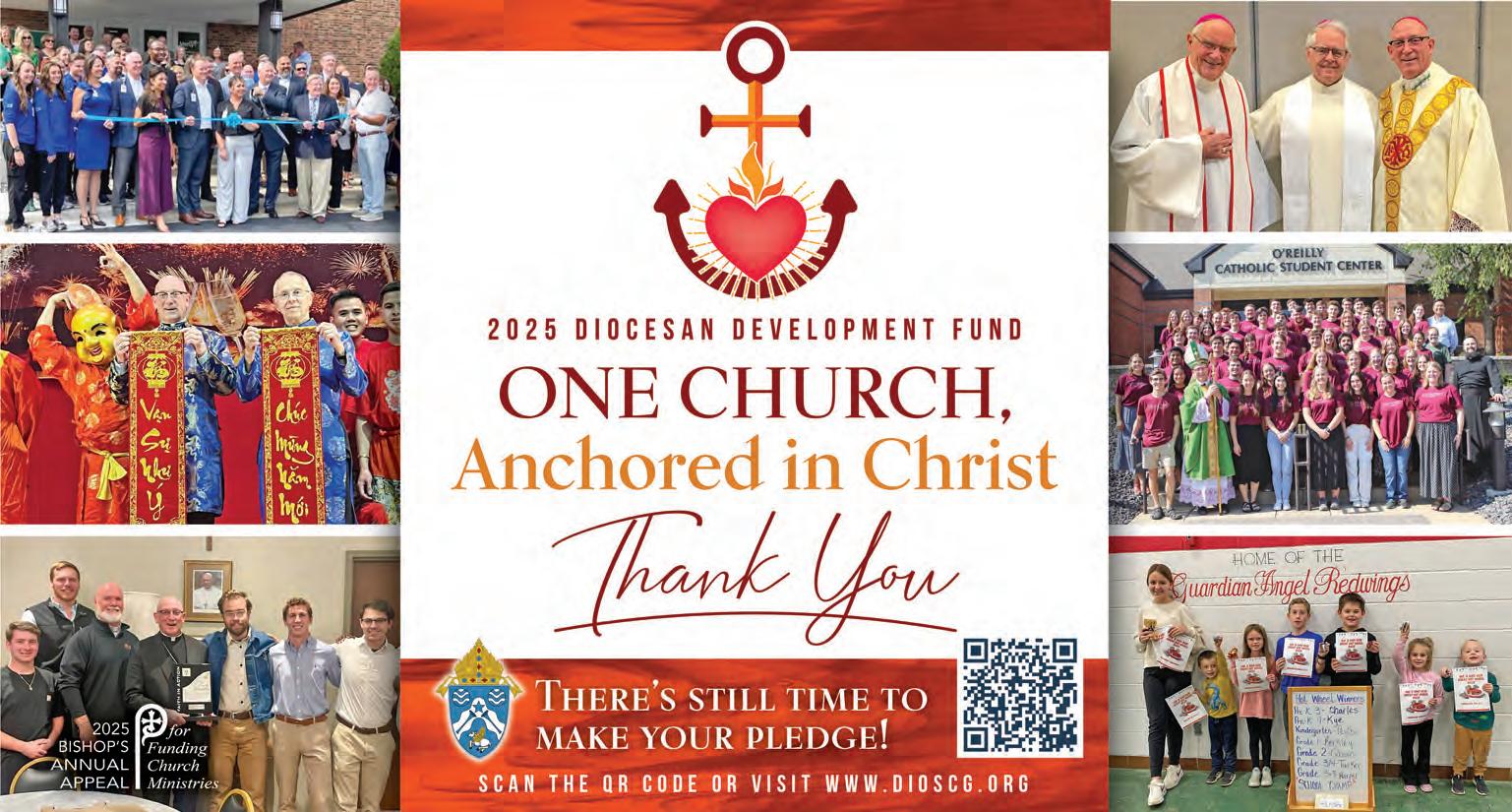
recent conclaves. By contrast, 115 cardinal electors— half of them from Europe— participated in the 2013 conclave that elected Pope Francis. In the 2025 conclave, 43% of electors were from Europe.
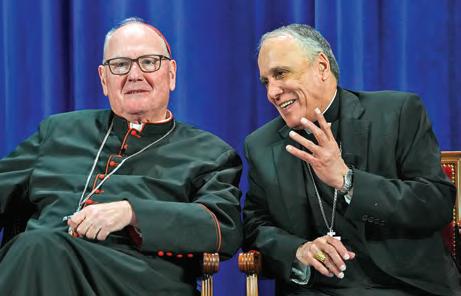
Prior to the conclave, the cardinal electors met for 12 general congregations, during which they shared their hopes, concerns, and priorities for the Church. The topics highlighted ranged widely, from evangelization, caring for the poor, and addressing clergy sexual abuse, to the economy, peace-building efforts, and synodality.
PRESS CONFERENCE—Cardinal Timothy M. Dolan, of New York, and Cardinal Daniel N. DiNardo, retired archbishop of Galveston-Houston, reflected on the conclave and the election of Pope Leo XIV during a news conference with US cardinals at the Pontifical North American College in Rome May 9, 2025. (CNS photo/Lola Gomez)
As a dicastery head, thenCardinal Prevost participated in both sessions of the 16th Ordinary General Assembly of the Synod of Bishops on Synodality that Pope Francis led in 2023 and 2024.
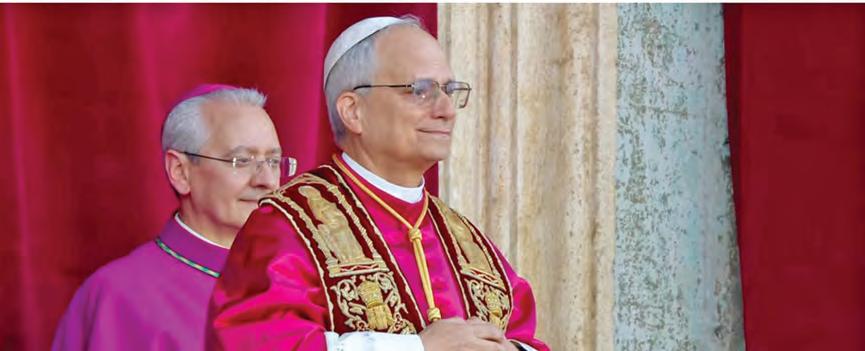
Pope Leo XIV: A biographical timeline
By Maria Wiering (OSV News)
The following are key dates in the life and ministry of Pope Leo XIV, elected May 8, 2025, as the 266th successor to St. Peter.
• 1955: Born Sept. 14 in the Chicago area.

Within days of the death of Pope Francis, many of the world’s 252 cardinals— including those over age 80 who were no longer eligible to elect a pope—were already in or arrived in Rome within days of Pope Francis’ death April 21. More than 220 cardinals, including then-Cardinal Prevost, attended his funeral on April 26.
Pope Leo has been commended for his interpersonal skills, with veteran American Vatican journalist John Allen, Jr., of Crux describing him as “a moderate, balanced figure, known for solid judgment and a keen capacity to listen.”
SOME CRITICISM
Pope Leo has also drawn criticism for his alleged role in the permissions given in 2000 for a priest of the Chicago Archdiocese, who had been credibly accused of multiple cases of child abuse, to live in an Augustinian friary less than a block from a school without informing the school.
While that situation occurred before the 2002 Dallas Charter, within which the US bishops established procedures for addressing clergy sexual abuse, then-Bishop Prevost has also been accused of not fully investigating three sisters’ sexual abuse allegations, made in 2022, against two priests in the Diocese of Chiclayo—a charge the diocese has denied.
The case has drawn global attention because as head of the Dicastery for Bishops, thenCardinal Prevost oversaw cases of clergy negligence under the worldwide norms Pope Francis established in 2019 with “Vos Estis Lux Mundi.”
In remarks given from St. Peter’s loggia before offering his first “urbi et orbi” blessing, Pope Leo commended Pope Francis’ final blessing of the world on Easter morning, the day before he died, saying, “Let me follow up on that same blessing: God loves us, God loves you all, and evil will not prevail! We are all in God’s hands. Therefore, without fear, united hand in hand with God and each other—let us go forward. We are disciples of Christ. Christ goes before us.”
Pope Leo also indicated he would continue the legacy of Pope Francis in developing a synodal style within the Catholic Church for the sake of its Gospel mission.
“ We want to be a synodal Church,” he said. “A Church that walks, a Church that always seeks peace, that always seeks charity, that always seeks to be close especially to those who suffer.”
The Augustinians’ Philadelphia-based Province of St. Thomas of Villanova announced earlier this year that it was presenting its 2025 St. Augustine Medal to then-Cardinal Prevost, with a celebration scheduled for Aug. 28, the feast of St. Augustine.
In that 2013 Rome Reports interview, then-Father Prevost spoke about God and St. Augustine, the fifth-century philosopher, theologian, and bishop who inspired the formation of the Augustinians in 1244.
“God is not someone or something that is absent and far away,” he said. “And Augustine, in his spirituality, in his struggles, in his reflections that we see, for example, in the ‘Confessions,’ is able to open a window ... and to lead others to come to discover how God is working in their lives.” ©OSV News
• 1977: Graduated from Villanova University near Philadelphia and entered the novitiate for the Order of St. Augustine in St. Louis.
• 1978: Professed first vows as a member of the Order of St. Augustine.
• 1981: Professed solemn vows as a member of the Order of St. Augustine.
• 1982: Ordained a priest of the Order of St. Augustine.
• 1984: Earned a licentiate in canon law from the Pontifical University of St. Thomas Aquinas (Angelicum) in Rome.
• 1985: Sent to work in the mission of Chulucanas, in Piura, Peru, until 1986.
• 1987: Elected the vocations director and missions director for his order’s Midwest province, Our Mother of Good Counsel.
• 1988: Moved to Trujillo, Peru, to direct a joint formation project for the region’s Augustinian aspirants. Over the course of a decade in Trujillo, he served as the community’s prior (1988-1992), formation director (19881998) and as an instructor (1992-1998).
• 1989: Began serving the Archdiocese of Trujillo for nine years as its judicial vicar; was also a professor of canon, patristic and moral law in the San Carlos e San Marcelo Major Seminary.
• 1999: Elected prior provincial for the Province of Our Mother of Good Counsel in Chicago.
• 2001: Promoted to his order’s prior general, considered its supreme authority that oversees its administration and governance. He was reelected to that role in 2007, holding it for a total of 12 years until 2013.
• 2013: Served for a year as a “teacher of the professed” and provincial vicar.
• 2014: Appointed by Pope Francis to be apostolic administrator of the Diocese of Chiclayo, Peru. He was simultaneously named a bishop, but of the titular diocese Sufar, under which title he was ordained a month later on Dec. 12, the feast of Our Lady of Guadalupe.
• 2015: Appointed bishop of Chiclayo on Sept. 26.
• 2018: Served as second vice president of the Peruvian Episcopal Conference until 2023.
• 2019: Appointed a member of the Vatican’s Congregation for the Clergy.
• 2020: While still bishop of Chiclayo, appointed apostolic administrator of the Diocese of Callao, Peru, a role he held until May 2021. He was also appointed to the Congregation for Bishops.
• 2023: Appointed prefect of the Dicastery for Bishops, named president of the Pontifical Commission for Latin America and granted the title archbishop Jan. 30; installed in those roles April 12. On Sept. 30, elevated to the College of Cardinals.
• 2025: Elected pope May 8, taking the name Leo XIV ©OSV News
‘A MISSIONARY AT HEART’: Catholic groups welcome Pope Leo XIV, first US-born pope
By Gina Christian OSV News
Catholic groups are welcoming Pope Leo XIV—the second pope from the Americas, and the first US-born pontiff—who was elected May 8, the second day of the papal conclave.
Catholic Relief Services, the official humanitarian agency of the Catholic Church in the US, released a statement moments after Pope Leo had delivered his “urbi et orbi” blessing.
CRS president and CEO Sean Callahan said the agency was “overjoyed by the election of Pope Leo XIV” and looks “forward to his leadership and guidance.”
Callahan called the election of the first US-born pope “a momentous occasion for American Catholics,” adding that “as the humanitarian organization for the US Church, CRS is proud to mark his historic election.”
GLOBAL EXPERIENCE
The former Cardinal Robert F. Prevost, a Chicago native, most recently served as the prefect for the Vatican’s Dicastery for Bishops. Prior to that appointment, he was the Bishop of Chiclayo, Peru, having lived there for more than two decades.
Callahan said that “global experience will surely have an impact on his papacy.”
“He has seen, firsthand, the struggles that our sisters and brothers around the world are experiencing,” Callahan said. “We are confident that he will be a voice for the voiceless and a fierce supporter of human dignity for all people.”
Callahan added that the new pope’s election “comes at a critical time for the global Church, as communities around the world navigate challenges such as increasing hunger, environmental degradation, and migration crisis.”
“As an organization committed to upholding dignity for every person, CRS stands ready to support the new Holy Father and continue working in communion with the global Church to build a more just, compassionate world,” said Callahan.
In a May 8 statement, Msgr. Roger J. Landry, National Director of The Pontifical Mission Societies USA, said Pope Leo had “a missionary heart,” and was one who “served for many years as a priest and bishop bringing Christ and his Gospel to the people in rural Peru.”
The societies, which operate at the service of the pope, consist of four mission societies designated as pontifical by Pope Pius XI in 1922, and serve 1,124 missionary dioceses and
territories worldwide.
“ We commit ourselves to praying for him (Pope Leo) and his intentions as he continues the work of Peter as a fisher of men throughout the globe,” said Msgr. Landry.
Msgr. Peter I. Vaccari, president of the Catholic Near East Welfare Association, said in a May 8 statement the agency “gives thanks to God and the prompting of the Holy Spirit as we rejoice” over Pope Leo’s election.
An agency of the Holy See and headquartered in New York, CNEWA was founded to work for, through and with the Eastern churches, connecting people of good will in building the Church, affirming human dignity, alleviating poverty, advancing dialogue, and inspiring hope.
“ We assure him (Pope Leo) of our prayers and our loyalty as we strive, following his words, to dedicate our mission in promoting the peace of the Risen Christ,” Msgr. Vaccari said.
Estrella del Paso, a Catholic nonprofit ministry that provides legal assistance to migrants in the Diocese of El Paso, TX, said in a May 8 statement that it was “heartened” by Pope Leo’s “clear alignment with the social teaching of the Church and Pope Francis on migration.”
The agency said the new pope “has long demonstrated a pastoral heart, especially toward migrants and those on the margins,” and that “as a bishop in Peru, he consistently emphasized the Church’s mission to walk with displaced and vulnerable populations. His ministry reflected a commitment to upholding the dignity of every person, particularly those forced to flee their homelands due to violence, poverty, or persecution.”
Curtis Martin, founder of the Fellowship of Catholic University Students, also known as FOCUS missionaries, said in a statement that Pope Leo’s election serves as “a powerful reminder that the Church is alive.”
“The world’s attention during the conclave and the growing number of conversions today are clear signs of a renewed hunger for truth and meaning,” Martin said.
He added, “May we be inspired with fresh zeal to live as missionary disciples and bring the hope of the Gospel to a world longing for light.”
©OSV News
Gina Christian is a multimedia reporter for OSV News. Follow her on X @GinaJesseReina.



POPE FRANCIS THEN-CARDINAL PREVOST CONSISTORY CARDINALS 2023—Pope Francis greeted then-Cardinal Robert F. Prevost during a consistory in St. Peter’s Square at the Vatican Sept. 30, 2023. US-born Cardinal Prevost became the first American pope in history when he was elected at the Vatican May 8, 2025, choosing the papal name Leo XIV. He succeeded Pope Francis, who died at age 88 April 21, 2025. (CNS photo/Vatican Media)
ELECTION OF POPE DRAWS WORLD ATTENTION—A media pool in St. Peter’s Square covered the conclave and subsequent election of US-born Cardinal Prevost as he became the first American pope in history when he was elected at the Vatican May 8, 2025, choosing the papal name Leo XIV. (CNS photo/Vatican Media)
POPE LEO XIV FIRST MASS—Pope Leo XIV celebrated his first Mass as pope with the cardinals who elected him in the Sistine Chapel at the Vatican May 9, 2025. (CNS photo/Vatican Media)
ADULT FAITH
Who was Pope Leo XIII?
By Russell Shaw OSV News
Cardinal Robert F. Prevost has selected the name Pope Leo XIV, an apparent nod to Pope Leo XIII, who deserves to be called the founding father of Catholic social doctrine in modern times, with his encyclical “Rerum Novarum” as its foundational document focusing on Rights and Duties of Capital and Labor.
The Catholic Church has taught social morality for many centuries. This body of teaching includes moral principles like the dignity and inviolability of the human person, the right to private property, the conditions for a just war, and much else.
As social conditions have changed, however, the Church’s social doctrine has expanded to take in new concerns.
Commonly known by the title, “On the Condition of the Working Classes,” the lengthy “Rerum Novarum” sets out a body of papal teaching in response to the state of industrial society in the late 19th century. In doing so, says Catholic writer Robert Royal, Pope Leo’s 1891 encyclical, “has shaped Catholic social teaching ever since.”
BIOGRAPHY
The future pope, Gioacchino Pecci, was born March 2, 1810, in Carpineto, a town in the hill country south of Rome, the sixth child in a family of the Italian minor nobility. A talented student, he studied at the Roman College and the Academy of Noble Ecclesiastics, the Roman training school for future members of the Vatican diplomatic service. He was ordained in 1837. He began his career as an administrator in the Papal States—first, as governor of Benevento and then of Perugia. In 1843, Pope Gregory XVI named him nuncio to Belgium. But there he involved himself in a dispute with the government over education policy, and the Belgian king requested his recall. He was then named archbishop of Perugia, a post he held from 1846-1878. He was named a cardinal in 1853.
After the 31-year pontificate of Blessed Pius IX, the cardinals at the conclave to elect his successor evidently wanted someone who would be an interim pope— in office just long enough to tweak the policies of his predecessor but then leaving the scene. Cardinal Pecci, nearing the age of 68 and believed to be in frail health, seemed to fit the bill on both counts. He was elected on Feb. 20, 1878. No doubt to the electors’ surprise, Pope Leo went on to serve as pope for 25 years, making his pontificate the third longest in history, after only those of Pius IX and Pope St. John Paul II.
On the political side, he achieved limited but real success, especially in Germany, where estrangement between the government and the Church was largely healed. Elsewhere—and especially in France and Italy—there was little or no improvement. But beyond the sphere of politics, the years of his pontificate saw significant growth for the Church in many places, along with a continued expansion of missionary efforts. He had little interest in ecumenism; after study by a papal commission, he declared in 1896 that Anglican orders were “absolutely null and utterly void.”
It has been said of Pope Leo XIII that in doctrinal matters he was as much of a traditionalist as Pope Pius IX and had even had a hand in writing that pope’s famous Syllabus of Errors.
Leo also continued to hope for a return of the temporal power of the papacy, at least in Rome if not in the rest of the former Papal States, now firmly in the hands of the government of a united Italy. But he brought to the papacy a comparatively gentle manner of expressing himself, together with a genuine desire for reconciliation between the church and the secular culture taking shape in the late 19th century.
On the intellectual level, one of his most significant actions was to promote a revival of the thought of St. Thomas Aquinas, the great 13th-century philosopher and theologian.
For Pope Leo, this was not an exercise in antiquarianism but a way of drawing upon the permanent resources to be found in the thought of the man whom he called, in his 1879 encyclical, “Aeterni Patris,” “the special bulwark and glory of the Catholic faith.” He called on the bishops to join him in promoting Thomistic studies and established an academy for this purpose in Rome.
Largely as a result of such efforts, the first half of the 20th century was to bring a flourishing of Thomism associated with Catholic thinkers like Jacques Maritain, Etienne Gilson, and Josef Pieper.
IMPACTFUL UPON THE CULTURE
But two other documents of Pope Leo stand out in particular. One is “Rerum Novarum,” dated May 15, 1891.
Responding to what he calls “socialism”—understood broadly to include any social movement or school of thought advocating the abolition of private property—Pope Leo here vigorously defended the right of private ownership as a natural right and necessary basis for the exercise of other rights. But in doing so, he positioned
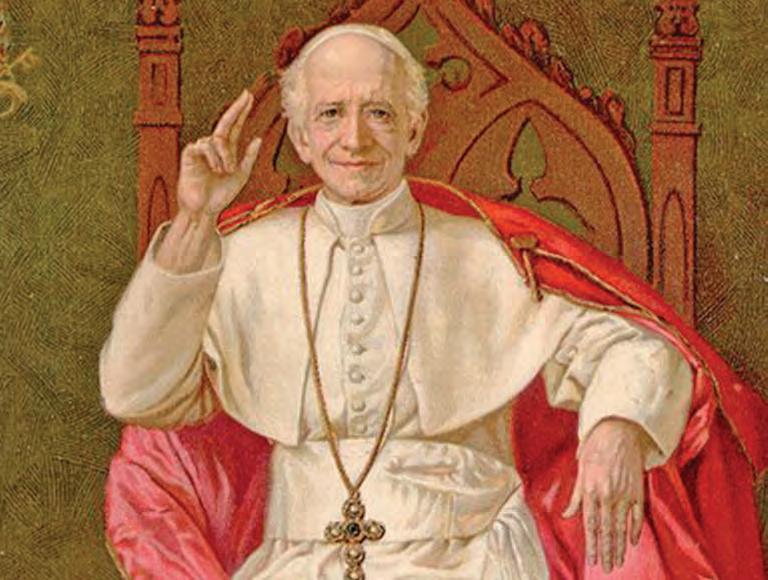
himself on the side of the working class, affirming such things as the right of workers to decent working conditions, a just wage, labor unions, and the right to strike.
The great novelty of “Rerum Novarum” does not lie in championing these things but in the fact that they are here championed by a pope, which historian Eamon Duffy calls “truly revolutionary.”
For American Catholics, it’s a point of particular interest that one of the influences on Pope Leo’s thinking in writing “Rerum Novarum” was the defense of an early workers’ organization called the Knights of Labor by Cardinal James Gibbons of Baltimore when the pope was leaning toward condemning the group as a secret society.
This intervention by the leader of the US hierarchy, soon to be reflected in the pro-labor stance of Leo’s encyclical, helped place the Church on the side of working people at a critical moment in the history of the labor movement.
The introduction of “Rerum Novarum,” setting the encyclical in the context of the social tensions of its time, is noteworthy in this regard. Writing of the “spirit of revolutionary change” then abroad in the world, Pope Leo said:
“The elements of the conflict now raging are unmistakable, in the vast expansion of industrial pursuits and the marvelous discoveries of science; in the changed relations between masters and workmen; in the enormous fortunes of some few individuals and the utter poverty of the masses; the increased self-reliance and closer mutual combination of the working classes; as also in the prevailing moral degeneracy. … There is no question which has taken deeper hold on the public mind.”
MORE THAN RERUM NOVARUM
American Catholics also will have a special interest in a second document
of Leo XIII—”Testem Benevolentiae” (“Witness to Good Will”)—containing a condemnation of “Americanism.”
The name “Americanism” refers to a set of ideas that the Vatican, rightly or wrongly, associated with the Church in the United States but that in fact may more commonly have been found in some Catholic circles in France. The real-life Americanizers—men like Cardinal Gibbons and Archbishop John Ireland of St. Paul, MN—had little interest in theories but were convinced of the need for Catholic immigrants to become integrated into American secular society. They denied having any personal sympathy with the “Americanism” condemned in Pope Leo’s letter, which is cast in the form of a letter to Cardinal Gibbons dated Jan. 22, 1899.
Whether or not Americanism was a problem then, the pope’s letter unquestionably does anticipate some real problems that have surfaced in American Catholicism in more recent times.
Among these are an understanding of the religious state that values activism over contemplation and thereby fosters “disregard for the religious life,” a dismissive attitude toward the Church’s teaching authority (“rejected as superfluous, nay even as useless”) in favor of individual reliance on the promptings of the Holy Spirit, and a pick-and-choose approach to doctrine that today is often called “cafeteria Catholicism.”
As pope, Leo XIII reigned with a decidedly monarchical style. But he was also, in the words of a papal chronicler, “a man of deep, conservative piety.” He died July 20, 1903, at age 93—the oldest man to occupy the papal office up to now and, thanks to Rerum Novarum, also among the most influential. ©OSV News
Russell Shaw, a veteran journalist and writer, is the author of more than 20 books, including three novels.
Between the sheep & secrecy: A NEW SOCIAL MEDIA GENERATION PREPARES TO ELECT THE POPE
By Ines San Martin Rome (OSV News)
The College of Cardinals prepared to elect a new pope included a visible group of Generation X and millennial electors—leaders shaped not just by the Second Vatican Council but by globalization, digital media, and a rapidly changing world.
Several cardinals under the age of 60, including some born in the 1970s and 1980s, brought new pastoral and communicative sensibilities to the conclave. Among them were Italian Cardinal Giorgio Marengo, a 50-yearold missionary in Mongolia; Portuguese Cardinal Américo Aguiar, 51, who led World Youth Day Lisbon; and Cardinal Mykola Bychok, 45, a Ukrainian Greek Catholic bishop serving in Australia.
There were at least 15 cardinals who were born after 1965—the year Vatican II ended—and the beginning of Generation X.
Content Creators, Influencers
“Many cardinals today are not just Church leaders or newsmakers—they are also content creators, influencers on social media,” said Gustavo Entrala, the Spanish communications expert who helped launch Pope Benedict XVI’s Twitter account. “Compared to 2013, there has been a major cultural shift: Many figures in the Church now share extensively Online, making it possible to scrutinize what they have said or written across social platforms.”
But the shift isn’t just generational— it’s technological. Many prelates now share updates directly on social media, often without a communications manager curating the content. Cardinal Aguiar posted a selfie with Cardinals Marengo and Bychok, taken in St. Peter’s Basilica, that briefly “broke” Catholic social media on Pope’s Francis’ funeral day April 26. Japanese Cardinal Tarcisio Isao Kikuchi of Tokyo, who heads Caritas Internationalis, posted on Facebook a bus selfie with fellow cardinals en route to pray at St. Mary Major.
These new forms of engagement show a College of Cardinals increasingly fluent in social media—raising new questions about transparency, discretion, and the evolving role of cardinals in the digital age.
Prayer Sought
Singapore’s only red hat, Cardinal William Goh, born in 1957, posted on X the conclave date only minutes after the Vatican spokesperson had confirmed it, noted that the cardinals are meeting daily in general congregations, and shared, in very general terms, what is happening.
“Hence, it is urgent and important that you all pray for us so that we can discern what kind of Pope the Church needs in this present day, because every Pope brings with himself his own charisms,” he posted. “Please pray that we will choose the right candidate to be the successor of St. Peter to lead the Church in this complex world.”
The same message was also shared on his Telegram channel.
Trapped Between Canon Law & Smell of the Sheep
Pope Francis was a strong advocate for clergy to stay close to their flock. Many prelates have found that social media, “the digital continent,” offers one more way to leave the sacristy and be part of a Church that “goes out,” as the late Argentine pontiff liked to say.
While the Church’s legal norms demand strict secrecy during the conclave, the broader challenge posed by the digital age is not merely legal but deeply spiritual.
As Giovanni Tridente, journalist and professor at Rome’s Pontifical University of the Holy Cross, observed, communication today touches not only techniques but the heart of pastoral life. For many cardinals, communication is no longer merely an option—it has become a space where proximity to the people of God is expressed.
“It is not simply a matter of technique, but of pastoral style,”
Tridente said. Some cardinals maintain a living bond with their communities through small, thoughtful gestures: a carefully chosen word, a measured public sign, a shared photo. Others, however, prefer complete discretion.
“Both paths deserve respect,” he added.
Yet, Tridente noted, the real challenge lies elsewhere: how to safeguard the essential when everything around demands visibility, immediacy, and storytelling?
“The conclave has always been a different kind of time,” he said. “It is not about isolating oneself from the world, but about setting it aside for a moment in order to look inward with greater clarity and freedom.” In this sense, he suggests, silence itself can become a profound form of communication.
“There is a real tension between the pastoral closeness many cardinals show Online and the radical discretion that a conclave demands,” Entrala said.
“In 2013, American cardinals were holding daily press briefings before the conclave until they were ordered to stop. We are seeing a historical echo of that now, as the camerlengo, Cardinal Kevin Farrell, did request cardinals not to speak publicly. It will be interesting to see how they managed their phones.”

The camerlengo is responsible for verifying the pope’s death, overseeing preparations for the conclave, and ensuring the smooth running of the Vatican during the “sede vacante.”
Even a traditionally private event like the conclave is now exposed to a constant flow of images, voices, and analyses—the mark of an era shaped by disintermediation, social media, and artificial intelligence.
“People consume content as never before, and due to Pope Francis, the Vatican is generating even more interest now than in 2013, following the historical resignation of Pope Benedict XVI,” Entrala said.
“And the more we know about the reality that surrounds us, the more engaged with it we want to be.”
Slow The Pace
This reality, Tridente argued, “is one that connects and informs, but that often overwhelms and distracts as well.” In this context, many cardinals, who may know little of each other beforehand, are inevitably influenced by fragmented narratives, preconceived perceptions, and external pressures.
`Precisely for this reason, Tridente told OSV News, Pope Francis’ invitation to “slow the pace” of the conclave and create spaces for silence, listening, and discernment becomes even more urgent.
`Canon law expert Kurt Martens, a professor at The Catholic University of America in Washington, emphasized that secrecy around the conclave is not simply a matter of tradition, but serves a crucial canonical and pastoral purpose: safeguarding the liberty of the cardinals.
`“We are drawn to the drama of secrecy— some of it encouraged by novels like Dan
Brown’s—but secrecy, and all the rules that surround it, have an important role to play,” Martens told OSV News. `“At all times, the goal is to protect the freedom of the cardinals from outside pressure.”
He recalled how, after a political veto influenced the 1903 conclave, Pope Pius X revised the law to excommunicate anyone attempting to interfere in a papal election—a principle expanded by Pope St. John Paul II to prohibit all outside influence, including that of groups or movements, under “Universi Dominici Gregis” (“Shepherd of the Lord’s Whole Flock”).
Today, Martens noted, social media presents new challenges.
“In 2013, social media was already present, but now it is far more pervasive,” he said. “Some cardinals miss opportunity after opportunity to remain silent and avoid influencing the conclave.”
Public posts, comments, and speculation, even outside the Sistine Chapel, risk undermining the very spirit of secrecy that canon law seeks to protect.
“Social media is a form of influence,” Martens warned. “Talking publicly, even in subtle ways, risks violating Universi Dominici Gregis Fortunately, there were a number of cardinals who stayed very quiet, not revealing what they were thinking— and that is exactly what they should be doing.” ©OSV News
Ines San Martin writes for OSV News from Rome. She is vice president of communications at the Pontifical Mission Societies USA.
SOCIAL MEDIA CARDINALS Portuguese Cardinal Américo Aguiar, 51, who led World Youth Day Lisbon, Cardinal Mykola Bychok, 45, a Ukrainian Greek Catholic bishop serving in Australia, and Italian Cardinal Giorgio Marengo, a 50-year-old missionary in Mongolia, are pictured in a selfie taken in St. Peter’s Basilica on April 26, 2025, the day of Pope Francis’ funeral.
(OSV News photo/Facebook of Cardinal Américo Aguiar)
ADULT FAITH/INTERNATIONAL NEWS
CHALLENGES THE NEW POPE WILL FACE & THE QUALITIES EXPERTS SAY HE’LL NEED
By Paulina Guzik Rome (OSV News)
In the days since the death of Pope Francis, cardinals have been meeting each morning at the Vatican to make decisions on the governance of the Church (in the absence of a pontiff) and to discuss the challenges facing the Church in the world, and what kind of Holy Father would be needed to meet them.
While some, like Austrian Cardinal Christoph Schönborn, retired archbishop of Vienna, believe that papacy is “too much of a challenge for anyone,” it’s inevitable that one of the men now dressed in red will leave the conclave dressed in white—most probably either May 8 or 9.
The challenge of leading a Catholic flock of 1.4 billion, from that moment on, will be on his shoulders. From theologians to Vatican insiders, there’s agreement that the next pontiff must balance deep faith with sharp governance.
STARTING POINT: BE A DISCIPLE OF CHRIST
“The first challenge for the next pope, as for any pope, is to be a vital, credible, compelling witness to Jesus Christ in his own person,” George Weigel told OSV News.
The author of Witness to Hope, the bestselling biography of Pope St. John Paul II, and distinguished senior fellow at Washington’s Ethics and Public Policy Center, Weigel recalled that John Paul started his inaugural Mass with words: “You are the Christ, the Son of the living God,” making a “firm Christological confession of faith.” This attitude, Weigel said, is much needed in the Catholic world today.
the paths of justice, fraternity, and peace.”
Echoing those words, the second virtue of the new pope would be, for Weigel, “the capacity to inspire throughout the world church a passion for mission.”
He said that Pope Francis, in his last Easter Vigil homily, “had a beautiful passage about the resurrection of the Lord who is the source of our fearlessness, and a pope with the capacity to inspire that kind of fearlessness ... that Resurrection-based fearlessness—in an increasingly divided and dangerous world—would be helpful.
For Austen Ivereigh, biographer of Pope Francis and author of The Great Reformer and Wounded Shepherd, the question of the missionary Church also touches on “what is the Church’s role in an era of me-first nationalism and empires competing to carve up the world? When countries not at the table are on the menu?”
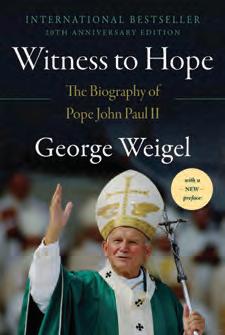

In a similar vein, Benedictine Father Donato Ogliari, abbot of St. Paul Outside the Walls in Rome, offered a first of two meditations for cardinals on April 29 starting precisely with a Christo-centric vision of the new pontificate: “At the heart of the wisdom the Church has accumulated over the centuries; at the center of the norms it needs in order to deal compactly with the vicissitudes of history ... there is always the person of Jesus, the Son of God made flesh, who died and rose again for our salvation!”
Father Ogliari told the cardinals: “What I am saying will seem obvious to you, and yet I believe that it is not useless to remind ourselves of it, because repositioning ourselves every day on this certainty of our faith preserves us from being engulfed by the suggestions and by the flatteries of the world.”
INSPIRE A PASSION FOR MISSION
Father Ogliari said April 29, ”The Church rooted in Christ is an open, courageous, and prophetic Church that abhors violent words and gestures, which knows how to be a voice for the voiceless and which, if necessary, also knows how to be a voice outside the chorus while pointing stubbornly
In a written statement sent to OSV News, he said that “this might lead the cardinals to consider an experienced diplomat or negotiator. But equally to think about focusing on the Church’s internal life, developing the internal culture which can help rebuild society—in other words, deepening synodality.”
Weigel pointed out, however, that regarding the Church’s diplomatic mission, it “would be helpful if the pope became again a vigorous supporter of religious freedom around the world, particularly in countries where Catholics are persecuted—like Cuba, Venezuela, and Nicaragua,” and the “China policy of the past pontificate should be quietly buried under the (new) pope.”
For his part, Greg Erlandson, a veteran American Catholic journalist, said that the area of diplomacy is “not an area that people think about: ‘Oh, the Vatican’s going to make the decisive move in that way.’ But it’s one of the only neutral powers that actually has a voice that is listened to, especially in the (Global) South.”
KEEP CATHOLICS TOGETHER
For Ivereigh, a “big dividing line within the cardinals” is “over how the Church evangelizes.”
“On the one hand are those who saw the Francis pontificate as showing how to evangelize the contemporary world—not primarily through handing down doctrines from above, but performing God’s mercy in direct, personal ways,” Ivereigh told OSV News. “On the other are those who want to return to a more reassuring (to them) style of Church: centralized, Western, clerical, and focused on doctrinal clarity. That’s where I see the tension.”
Given these and other challenges, Erlandson, who is the former editor-in-chief for Catholic
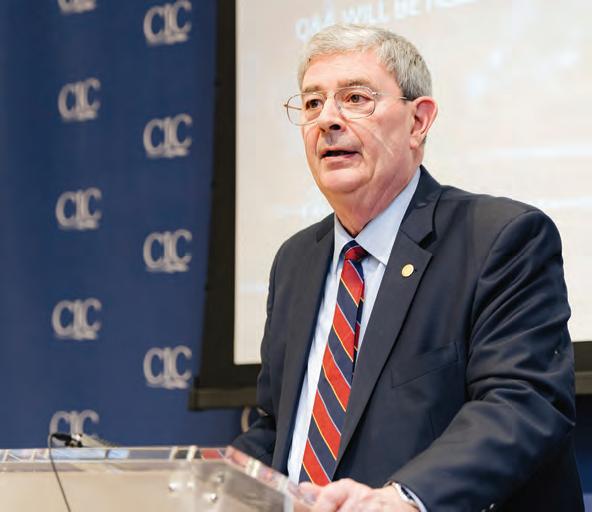

CHALLENGES FACING NEXT POPE—Pope Francis greeted Austen Ivereigh, author of papal biographies, during the assembly of the Synod of Bishops Oct. 16, 2023. On April 30, 2025, amid papal transition, Ivereigh told OSV News a “big dividing line within the cardinals” is “over how the Church evangelizes.” (CNS photo/Vatican Median)

CHALLENGES FACING NEXT POPE Greg Erlandson, former editor-in-chief of Catholic News Service, said: “Someone’s going to have to find a way” to keep Catholics together amid divisions. (OSV News photo/courtesy Greg Erlandson)
CHALLENGES FACING NEXT POPE George Weigel, senior fellow at the Ethics and Public Policy Center, speaking to OSV News in Rome April 30, said, “The first challenge for the next pope, as for any pope, is to be a vital, credible, compelling witness to Jesus Christ in his own person.” (OSV News photo/Frankie Garcia, Kalorama Studios)
News Service, said, “Someone’s going to have to find a way” to keep Catholics together.
“Francis threw a lot of balls in the air, but he hasn’t resolved everything,” Erlandson told OSV News. He pointed out that issues such as divorce and remarriage, synodality, or matters concerning LGBTQ Catholics “were in many ways unresolved in some really definitive ecclesial sense.”
Pope Francis “created an opening that ‘the Church is for everyone,’ the door is always open. That’s true. And yet, what does that really mean in terms of the doctrine? ... I think that’s going to be critical to resolve, and it’s going to be very dangerous for the Church because there are many expectations on one hand, and there are certainly legitimate concerns about where we stand in terms of doctrine,” Erlandson said.
For Weigel, “The unity worth pursuing in the Church is unity in truth.”
He pointed out, “Germany comes immediately to mind.”
“It’s not a question of schism. It’s a question of apostasy,” he said. “You have to invite these people back into a full acceptance of the creed and the catechism. That’s the unity that’s worth pursuing.”
John Paul’s biographer said, ”It’s important for the pope to choose the battles he wishes to fight.
“ Whenever the Church is persecuted, the pope’s voice can provide some measure of protection for persecuted people,” he said.
“But the papacy is not the Catholic equivalent of the Oracle of Delphi,” he added, referring to the ancient Greek sanctuary and oracle, famous for its cryptic prophecies given by the priestess, Pythia.
“Popes may have personal opinions on lots of things,” Weigel said, “but those are personal opinions, and it’s best to keep them to himself. So I would say concentrate on the large issues: pro-life, religious freedom. Find ways to make a peace that is truly a peace because it’s based on justice,” and not having “an opinion on every contested issue of international politics.”
REFORM GOVERNANCE, FINANCES
Listing the important aptitudes of the next man in white, Weigel also underlined the “capacity for governance,” a feature with which the new pope needs to face challenging reforms—including the reform of finance.
At the April 30 general congregation, 181 participants in attendance, including 124 cardinalelectors, listened to a report by Cardinal Reinhard Marx, coordinator of the Council for the
ADULT FAITH/INTERNATIONAL NEWS/ADVERTISING
Economy. He “presented an up-to-date overview of the existing challenges and critical issues, offering proposals geared toward sustainability and reiterating the importance of the economic structures continuing to provide stable support to the mission of the papacy,” the Holy See statement said.
For Ivereigh, “further reform to Vatican governance, especially in finance, and the need for a more normative and less personalistic governance” is a task for the new pope. “Some dicasteries such as communications need particular attention,” he said.
Weigel added, “The reform of the Vatican financially, bureaucratically and otherwise was not adequately addressed over the past 12 years.”
“People are tired of this,” he added. “The financial situation is quite dire, and this mismanagement, and in some cases outright corruption, has got to stop.”
OSV News’ interviews took place a day after Italian Cardinal Angelo Becciu, convicted for financial misconduct, announced he was withdrawing from participating in the upcoming conclave.
REFORM ON SEXUAL ABUSE
Despite some advancements made by Pope Francis—and amid some setbacks—the Church still needs to have a full reckoning with the clergy sexual abuse crisis globally.
“Investment in procedures for handling abuse claims that establish clear norms and enable greater transparency and accountability, to show that the Church is acting and justice is being done,” is needed under the new pope, Ivereigh said.
For Weigel, “the problem of clerical sexual abuse has not even begun to be dealt with seriously in parts of the world, other than North America. And that needs to be addressed.”
“At the same time, not every accusation is a legitimate accusation. People have a right to their good name and they have a right to due process. So finding that balance is an important thing,” Weigel said.

Erlandson, author of Pope Benedict XVI and the Sexual Abuse Crisis, for his part added that he “applauded Francis for his willingness to admit he was wrong in terms of Chile,” referring to a moment
remembered by many victims as the moment of Pope Francis’ conversion after his apostolic trip to Chile in 2018.
“And I also applauded him for bringing together the heads of the bishops’ conferences. I thought that was terrific,” Erlandson said. “But the truth is that he struggled. He was a man of the older generation.”
Erlandson added, “The Vatican is going to have to become more open, or they’re going to continue to lose the confidence of their members. That’s really dangerous.”
Weigel affirmed that for whoever is chosen to be the next pope, he “has to
have good judgment in people” as “you can’t do this by yourself.”
“You have to build a team of people who share your vision and who have the competence to execute it,” he added.
©OSV News
Paulina Guzik is international editor for OSV News. Follow her on X @Guzik_Paulina.

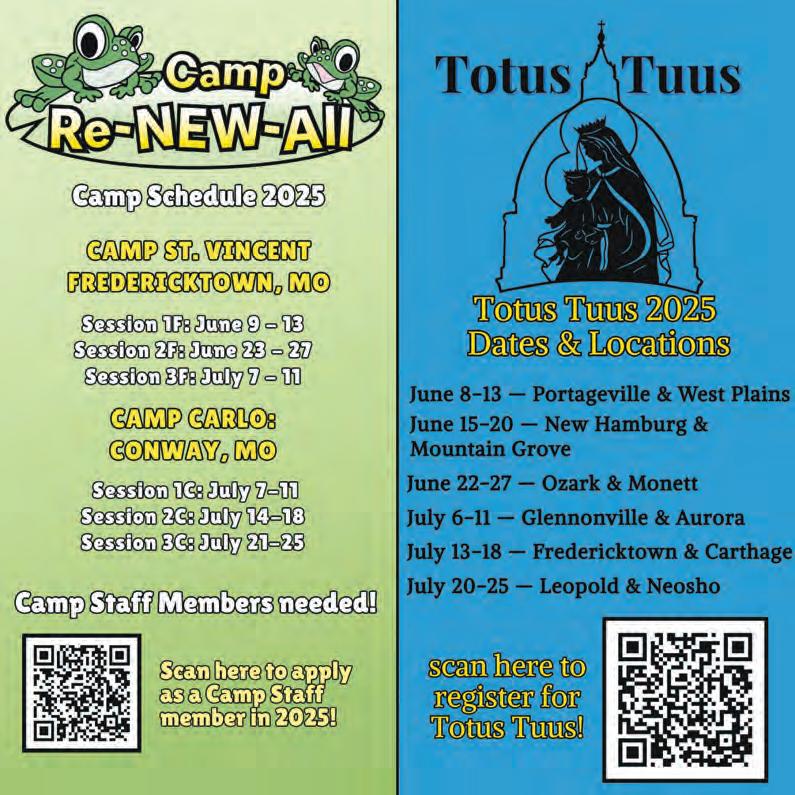


SUMMER CAMPS AT NOTRE DAME
Notre Dame Regional High School, Cape Girardeau, is excited to host a variety of sports, arts and science camps this summer! Camps are for students entering K-8th grade next school year.
ADULT FAITH/DIOCESAN NEWS
Pope Francis, RIP
By Scott P. Richert OSV News
In a casual aside in an article two or three years into Pope Francis’ pontificate, and a year or two before I came to Our Sunday Visitor, I wrote that the Holy Father was not (as both his supporters and detractors claimed) the first “Third World Pope” or “Pope from the Global South” but rather a thoroughly European and even Italian one.
He had (I had argued in numerous articles) more in common with his immediate predecessors, Pope Benedict XVI and Pope St. John Paul II, than most commentators were willing to admit.
As different as they were from one another, John Paul, Benedict, and Francis were all pastors at heart, men who understood that doctrine and dogma are distillations of truth— formulated as Christians grapple with their encounter with Christ and not in themselves the path to that truth. Each in his own way called modern men and women to that encounter, because all three recognized that the memory of Christ was fading, and fading fast, especially in Europe and the countries of the western hemisphere and
the global south that had been colonized by European Christians.
In sheer numbers, there have never been so many Christians as there are today; in a deeper sense, however, the smaller Church predicted by the future Pope Benedict in 1969, a Church that “will have to start afresh more or less from the beginning,” is already here.
Pope Francis declared Pope Benedict a “prophet of this Church of the future,” and throughout his entire pontificate, Francis heeded his call. If doing so seemed messy at times, so be it.
Pope Francis had little patience for those who have traded the encounter with Christ for the ossified ruins of Christendom. In his apostolic exhortation “Christus Vivit,” he declared, “Christ is alive! He is our hope, and in a wonderful way he brings youth to our world, and everything he touches becomes young, new, full of life.”
This thread that connects John Paul II, Benedict, and Francis—this hermeneutic of continuity—had convinced me by early 2017 that not only are there no political solutions to cultural problems, but there are no cultural solutions to those problems, either. There is only a religious one,


and it must begin with our personal encounter with Christ.
Throughout his pontificate, with the fire and occasional cantankerousness of some of the early fathers of the Church, Pope Francis admonished us to quit worrying about the sins, real and imagined, of others, and to see in them the face of our Savior—and to serve him through serving them.
For this, some thought he did not believe in the reality of sin. They apparently never bothered to read any of the homilies from his daily Masses, in which the Holy Father spoke frequently of sin, the devil, and hell, and attacked the ideologies of left and right— including the “ideological colonization” of family life—for presenting a secular, structural alternative to the very real and necessary work of discerning God’s will and doing it.
From St. Peter on, the office of the papacy has been occupied by men who were not perfect, and Pope Francis was no exception. But at his best, he shared with his immediate predecessors a twinkle in his eye and a welcoming smile that rose from the joy in his heart—the joy of encountering the risen Christ and the joy of sharing him with others. That joy can overcome all fear, all division, all strife. That joy can and must move us to make Christ known to all nations, to become true missionary disciples, to hand down the truth of the encounter with Christ by creating the conditions in which those who do not yet know him may come to do so. This is the legacy of Pope Francis. May God grant him blessed repose and eternal memory. ©OSV News
Scott P. Richert is publisher for OSV


The
VIRTUS
Protecting God’s Children Safe Environment training for adults is available online.
Preregistration is necessary: If you are a new registrant please go to www.virtus.org and click on “first time registrant” on the left, and follow the prompts to register for Online training. Instructions for the registration process can also be found on the Child and Youth Protection Page of the diocesan Website.
www.dioscg.org/wp-content/uploads/How-to-Register-for-a-VIRTUS-withOnline-Option.pdf
Both in-person and online training sessions are for adults only.
Before engaging in activities involving minors and/or vulnerable adults, new volunteers or employees are required to complete the VIRTUS Protecting God’s Children training for adults, submit a current Background Disclosure and Authorization Form, and read, sign and submit the annual Code of Conduct, which are available on the VIRTUS Website and the Diocese of SpringfieldCape Girardeau Child and Youth Protection Webpage: www.dioscg.org/child-youth-protection/ For more information, please contact the Office of Child and Youth Protection, childandyouthprotection@dioscg.org; or Bill Holtmeyer, billholtmeyer@dioscg.org; or Shelly Ferry, sferry@dioscg.org, (417) 866-0841
FRANCISCO—A single white rose atop the tomb of Pope Francis in the Basilica of St. Mary Major in Rome (CNS photo/Vatican Media)
